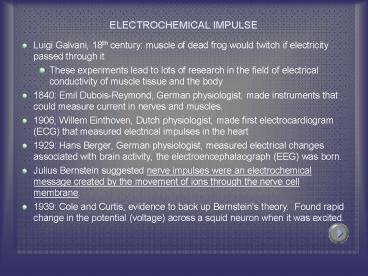ELECTROCHEMICAL IMPULSE PowerPoint PPT Presentation
1 / 6
Title: ELECTROCHEMICAL IMPULSE
1
ELECTROCHEMICAL IMPULSE
- Luigi Galvani, 18th century muscle of dead frog
would twitch if electricity passed through it - These experiments lead to lots of research in the
field of electrical conductivity of muscle tissue
and the body - 1840 Emil Dubois-Reymond, German physiologist,
made instruments that could measure current in
nerves and muscles. - 1906, Willem Einthoven, Dutch physiologist, made
first electrocardiogram (ECG) that measured
electrical impulses in the heart - 1929 Hans Berger, German physiologist, measured
electrical changes associated with brain
activity, the electroencephalaograph (EEG) was
born. - Julius Bernstein suggested nerve impulses were an
electrochemical message created by the movement
of ions through the nerve cell membrane. - 1939 Cole and Curtis, evidence to back up
Bernstein's theory. Found rapid change in the
potential (voltage) across a squid neuron when it
was excited.
2
RESTING POTENTIAL
- Found that the resting potential of the nerve was
-70 mV. - More negative charges on the inside of the nerve
cell than outside. - When the nerve became excited, the potential went
up to 40 mV and this was termed the action
potential. - The action potential did not last long and the
nerve cell went back to its resting potential. - It has been found that it is the movement of
positive ions that causes the potential to change
in a nerve cell, not the negative ions. - The highly concentrated potassium ions want to
diffuse out of the nerve cell, while the highly
concentrated sodium ions want to diffuse in...why
does the potential change if they both have the
same charge? - The resting membrane is more permeable to
potassium diffusion than sodium diffusion. - This means more potassium is moving out than
sodium moving in and consequently the outside of
the nerve cell is more positive than the inside.
3
NERVE IMPULSE
- This leads to why the resting potential is -70
mV. There are fewer positive ions inside the
nerve cell than outside. - The resting membrane is said to be charged or
polarized. - When the nerve cell becomes excited, it becomes
more permeable to sodium than potassium.
Scientists believe that sodium and potassium
gates open and close opposite of one another. As
one type of gate opens, the other closes. - Sodium rushes into the cell which causes a
reversal of charge called a depolarization. - Once the voltage becomes positive, the sodium
gates close. That is why the max action
potential under normal situations is only 40 mV. - Sodium-potassium pumps actively restore the
original resting potential by moving sodium out
and potassium back in. This is called
repolarization.
4
NERVE IMPULSE
- Nerve cells cannot transport a second message
until the resting potential is reset. This is
called the refractory period, the time it takes
the nerve cell to be repolarized. - Depolarization moves along the axon of the nerve
cell in a wave. - The critical amount of electricity that is
required from a nerve cell to fire is known as
the threshold level. Stimuli below this level do
not initiate a response. - Any amount of stimulus above the threshold level
gets the same response from the nerve cell. - Nerve firing is an all-or-none response. It
fires maximally or not at all. - Homework Handout Questions 1-15
5
SYNAPTIC TRANSMISSION
- The spaces between neurons and adjacent neurons
or effectors are known as synapses. - Synapses usually involve many neurons.
- The nerve impulse moves along the presynaptic
neuron and causes chemicals called
neurotransmitters to be released into the
synapse. They diffuse across the synaptic cleft
and attach to membrane receptors on the
postsynaptic neuron. This causes the
depolarization to continue on. - The diffusion of neurotransmitters is a slow
process, so a neural response that involves many
synapses takes a relatively longer time than a
simple reflex arc. - Acetylcholine is an example of a
neurotransmitter. - It is an excitory neurotransmitter as it causes
depolarization to continue in the postsynaptic
neuron by opening sodium gates.
6
SYNAPTIC TRANSMISSION
- In order to return the postsynaptic neuron to
resting potential, the sodium gates must be
closed. This is indirectly done by
cholinesterase, an enzyme that breaks down
acetylcholine and thus shuts the sodium gates. - Many neurotransmitters can have an inhibitory
action on a neuron by making postsynaptic neurons
more permeable to potassium. This causes even
more potassium to leave the cell and thus causes
even more potassium to leave the cell and thus
causes the potential to be even more negative or
hyperpolarized. - Summation is when two or more neurons are needed
to create an action potential in a further
neuron. The sum of their firing causes an action
potential in the postsynaptic neuron. - Homework Questions 16 - 24

